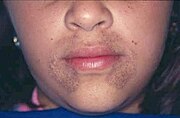Alkaptonuria
| Alkaptonuria | |
|---|---|
 |
|
| Pigmentation of the face in alkaptonuria | |
| Classification and external resources | |
| Specialty | endocrinology |
| ICD-10 | E70.2 (ILDS E70.210) |
| ICD-9-CM | 270.2 |
| OMIM | 203500 |
| DiseasesDB | 409 |
| MedlinePlus | 001200 |
| eMedicine | ped/64 |
| Patient UK | Alkaptonuria |
| MeSH | D000474 |
| GeneReviews | |
Alkaptonuria (black urine disease, black bone disease, or alcaptonuria) is a rare inherited genetic disorder in which the body cannot process the amino acids phenylalanine and tyrosine, which occur in protein. It is caused by a mutation in the HGD gene for the enzyme homogentisate 1,2-dioxygenase (EC 1.13.11.5); if a person inherits abnormal copies from each parent (it is a recessive condition) the body accumulates an intermediate substance called homogentisic acid in the blood and tissues. Homogentisic acid and its oxidized form alkapton are excreted in the urine, giving it an unusually dark color. The accumulating homogentisic acid causes damage to cartilage (ochronosis, leading to osteoarthritis) and heart valves as well as precipitating as kidney stones and stones in other organs. Symptoms usually develop in people over thirty years old, although the dark discoloration of the urine is present from birth.
Apart from treatment of the complications (such as pain relief and joint replacement for the cartilage damage), vitamin C has been used to reduce the ochronosis and lowering of the homogentisic acid levels may be attempted with a low-protein diet. Recently the drug nitisinone has been found to suppress homogentisic acid production, and research is ongoing as to whether it can improve symptoms. Alkaptonuria is a rare disease; it occurs in one in 250,000 people, but is more common in Slovakia and the Dominican Republic.
...
Wikipedia
